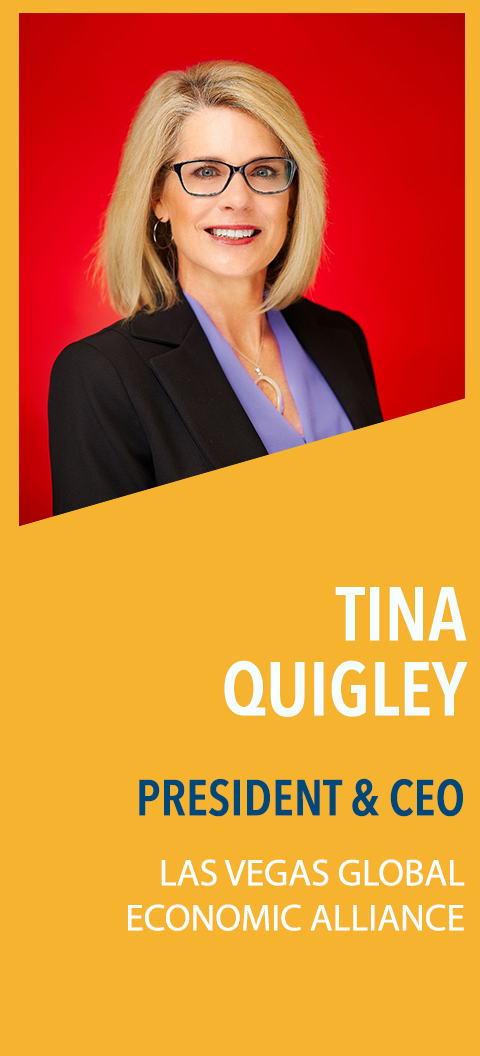Perspective Update | May 2022
 |
|
|
|
LVGEA’s economic development and diversification efforts do not exist in a vacuum. Rather, it’s a two-way street alongside investment in the region’s infrastructure. A healthy and safe infrastructure allows businesses to connect with customers, import and export goods, while also creating jobs. In this Infrastructure edition of the Perspective Update, you’ll find insightful commentary from LVGEA President & CEO Tina Quigley, who spent many years in the transportation industry, about why it’s important for the community to recognize the importance of investment in infrastructure. Plus, take a look at our community survey results on infrastructure, updated market information, and an economic update from Applied Analysis. |
|
Now in its 42nd year, Las Vegas Perspective is the region’s go-to source for community and economic development information, analysis, and forecasting. This year’s event will be held Thursday, June 23 at The M Resort. |
Guest Columnist |
 |
|
Southern Nevada has always gone through boom-and-bust cycles, which is why LVGEA’s mission is to diversify the region’s economy to protect against the next economic downturn. But thanks to a few local leaders who had the foresight to invest in infrastructure improvements, the region has been able to continue record-setting growth despite some economic setbacks. When we speak of infrastructure, we don’t just mean our roadways. It also means our water systems, public transportation, and commercial airports. Thanks to the investments made over the past decades, Nevada was ranked as having the country’s best infrastructure in the American Society of Civil Engineers 2021 Infrastructure Report Card. While a #1 infrastructure ranking might not seem super sexy, it is 100% a selling point for businesses looking to relocate to Southern Nevada. Take for example, the 53-mile Bruce Woodbury Beltway, which circles three-quarters of the Las Vegas valley. Clark County leaders had a vision of what Las Vegas could become and planned accordingly. Construction of the beltway was planned and paid for by the county, the first time a county had overseen the construction of an interstate highway with little to no state or federal funding. Now almost completely built out, the road’s existence has allowed the region to access thousands of acres of new land for commercial and industrial development, bringing billions of investment dollars to the region. Additionally, the construction of the so-called ‘third straw’ into Lake Mead secured the region’s access to its primary water supply for years to come. As water levels continued to drop in the 2000s, the Southern Nevada Water Authority crafted a plan to build a tunnel under the lake and pipe water from the bottom, versus the pipe coming from above the surface. Completed in 2015, the new intake pipe, which is located 600 feet beneath the lake, took 3 years to build and at a controversial price tag of $817M. While expensive, the gamble paid off. Just weeks ago, the lake’s water level dipped below the SNWA’s second (surface) intake pipe. Without the ‘third straw’, the region would be under severe conservation measures that would almost surely hamper economic growth. As Las Vegas continued to grow, so too did the Harry Reid International Airport, which is ranked as the 7th busiest airport in the nation by the FAA. Pre-pandemic, the airport served a record 51.5M passengers in 2019. Not only is the hospitality industry reliant on the airport to welcome additional visitors every year but having an international transportation hub allows businesses to better serve their clients and to recruit top talent. When the LVGEA Business Development teams talks to companies about why they want to locate to Southern Nevada, we regularly hear that the global reach of the airport helps them meet their business needs. Additionally, planning continues for the Southern Nevada Supplemental Airport, a second commercial airport in the Ivanpah Valley near the California border. As you can see, infrastructure is what allows a community to become prosperous. Our region’s next infrastructure challenge is the need to create more development-ready industrial land. LVGEA and our municipal economic development partners get requests every day from companies looking to expand into Southern Nevada, but developable industrial land is becoming scarce. North Las Vegas is currently working to build infrastructure to the Apex Industrial Park in the northeast part of the valley, and plans are underway for an industrial park south of town in Sloan, with additional land available in the El Dorado valley. The only thing preventing companies from opening shop right now is a lack of infrastructure. So, while ‘infrastructure’ might not be the most exciting topic to talk about, it is an essential piece of the puzzle that companies look at when they are deciding where to relocate. I think the region is at an exciting crossroads, as both community leaders and residents begin to recognize the importance of infrastructure investment. Tina Quigley is President & CEO of the Las Vegas Global Economic Alliance. Previously, she served as CEO of the Regional Transportation Commission of Southern Nevada, overseeing the region’s public transportation, road construction, and regional planning. |
Infrastructure Survey |
|
This community survey examined opinions and attitudes of the Southern Nevada workforce testing sentiments around our region’s infrastructure. This web-based survey was commissioned by Las Vegas Global Economic Alliance and conducted in Spring 2022. Since this survey is intended to poll the Clark County workforce, results remove self-selected retirees and unemployed workers as well as self- selected residents of other counties. The sample size of the survey is 500 with a margin of error of +/- 3.7 percent at the 90 percent confidence interval. |
 |
Updated Regional Economic Statistics |
 |
Economic Perspective |
 |
|
Looking back over the first half of 2022, it is clear that Southern Nevada is continuing its upward trajectory in recovering from COVID-19 and the related health response. The majority of economic indicators have experienced positive growth over the past year, and continued development activity within the region underscores a community looking towards the future. Total employment reached 1,048,000 in April 2022 (latest available data), a 10.3 percent growth over the previous year and a mere 1,700 jobs (-0.2 percent) under pre-pandemic levels seen in February 2020. The Las Vegas metropolitan statistical area (MSA) experienced the second-fastest year-over-year growth in the United States, behind only Atlantic City, New Jersey (compared to 351 MSAs). In addition, employment growth was more than three times greater than the average MSA growth rate of 3.33 percent noted across the nation. Equally encouraging trends are reflected in the overall unemployment rate, which dropped 5.3 percentage points over the last year to 5.0 percent. Although still above the national average (3.3 percent), Southern Nevada’s unemployment rate saw the most significant decrease across metro areas and marks the twelfth consecutive month of year-over-year declines. Tourism metrics in Southern Nevada also showed sustained improvement. Visitation in April 2022 was 36.4 million (trailing-twelve-month total), which represented a doubling of the value reported from the previous year. This month is one of the highest visitation numbers since the beginning of the pandemic, likely bolstered by the recent NFL Draft and a series of high-profile concerts held at Allegiant Stadium. Meanwhile, gross gaming revenue continues to break records, with a new all-time monthly high achieved in March 2022 of $1.18 billion, 1.4 percent higher than the previous record from July 2021. Although gaming revenue dipped to just under $1.0 billion in April 2022, trailing-twelve-month totals still represent a 73.0 percent year-over-year increase. Questions remain regarding the sustainability of these gaming revenue trends, but it will be important for key components within the industry to continue their recovery, including the convention segment and overall international visitation. Concurrent with rising visitation, housing demand and employment, a number of major projects in Southern Nevada are under construction or in the planning stages that are expected to supplement existing infrastructure in and around the valley. There are currently 100 projects totaling $31.2 billion in the development pipeline. While not all projects will move forward as currently planned, the restart of projects like the Fontainebleau Las Vegas ($3.1 billion) provide increased tourism infrastructure in support of future recovery. However, the majority of projects in the pipeline (61 total) represent non-tourism and transportation-related assets. For example, plans for a 135-acre medical campus in North Las Vegas continue to move forward that are expected to provide a multi-year, phased development to support expanded medical infrastructure and investment to an emerging part of the urban Las Vegas valley. Other notable infrastructure investments include the Haas Automation manufacturing plant, a 2.5 million square foot manufacturing facility slated within the City of Henderson. The investment highlights another opportunity to diversify the employment base and seed additional investments. There are a number of other examples that are expected to assist in building out the community’s infrastructure and provide increased stability to the employment base. Overall, it appears that Southern Nevada is poised for continued expansion. Employment is gradually improving, the tourism industry is welcoming increased visitation and the development pipeline has a robust and diverse list of projects designed to strengthen the community’s infrastructure. Inflationary pressures, supply chain challenges, rising interest rates and various cost of living increases (gas and food prices) will be important factors to monitor going forward, along with their interplay within the performance of the national economy and consumer travel decisions. |
|
|
|
This newsletter is made possible with the support of our PERSPECTIVE Council: |
 |
 |
 |
 |
 |
 |
 |
%20Header%20-%20Template.png?width=1120&upscale=true&name=Perspective%20(Infrastructure)%20Header%20-%20Template.png)

